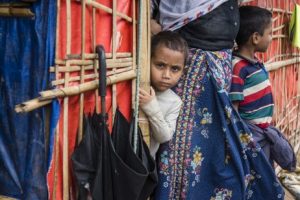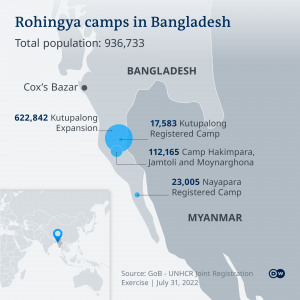
The attitude towards Rohingya people in Myanmar seems to be changing. However, the return of refugees from neighboring Bangladesh five years after the army drove them out is not expected any time soon.
Five years ago, Myanmar’s army launched what it called “clearance operations” against the Muslim-minority Rohingya people in Rakhine State, which borders Bangladesh.
Civilians were murdered, girls and women were raped and entire villages were razed to the ground. About 700,000 Rohingya fled to neighboring Bangladesh, where most remain to this day in refugee camps.
Myanmar’s armed forces said the campaign was in response to attacks mounted several days earlier on police stations by the Arakan Rohingya Salvation Army (ARSA), a militant resistance group. The UN and human rights organizations judged the retaliation as disproportionate. The army is accused of committing crimes against humanity and genocide. Currently, a case against Myanmar for violating the Convention on the Prevention and Punishment of the Crime of Genocide is pending before the International Court of Justice in The Hague.

Decades of discrimination
The Rohingya are not recognized by Myanmar as a distinct ethnic group and have been subject to discrimination and demonization for decades. Many lack citizenship rights and cannot move around freely, send their children to school or access medical care. Presently, over one million Rohingya live in Bangladesh, and some 300,000 to 400,000 live in other foreign countries. But about 400,000 Rohingya still live in Myanmar, mostly in camps near Sittwe, the capital of Rakhine State. This is where most of the Rohingya in the country lived before being driven out. But the dominant population in the state is made up of the Arakanese, a Buddhist ethnic group, who have been in conflict with the central government and military for decades.
Though most Rohingya have lived in Myanmar for generations, many others in the country regard them as illegal migrants from neighboring Bangladesh. They also accuse them of having too many children, or marrying Buddhist women and thereby threatening the country’s Buddhist traditions. This is unlikely to happen given that 87% of the population is Buddhist. It was influential nationalist monks who spread the myth of a Muslim takeover in incendiary sermons and on social media ahead of 2017. Studies have shown that the smear campaign caught on because anti-Rohingya prejudice and systematic discrimination had been widespread for decades.
Changing attitudes?
However, attitudes towards the Rohingya have changed since the coup in February 2021 and the army’s jailing of Aung San Suu Kyi, and brutal crackdown on protests. Now that the army has targeted the majority ethnic Bamar population, there is also a certain form of solidarity, particularly among Generation Z. Young activists, some of whom have turned their back on the policies of Aung San Suu Kyi’s National League for Democracy (NLD), are fighting the military and demanding “justice for the Rohingyas” — whatever that may actually mean.
Source- dw.com, 24 August 2022.



